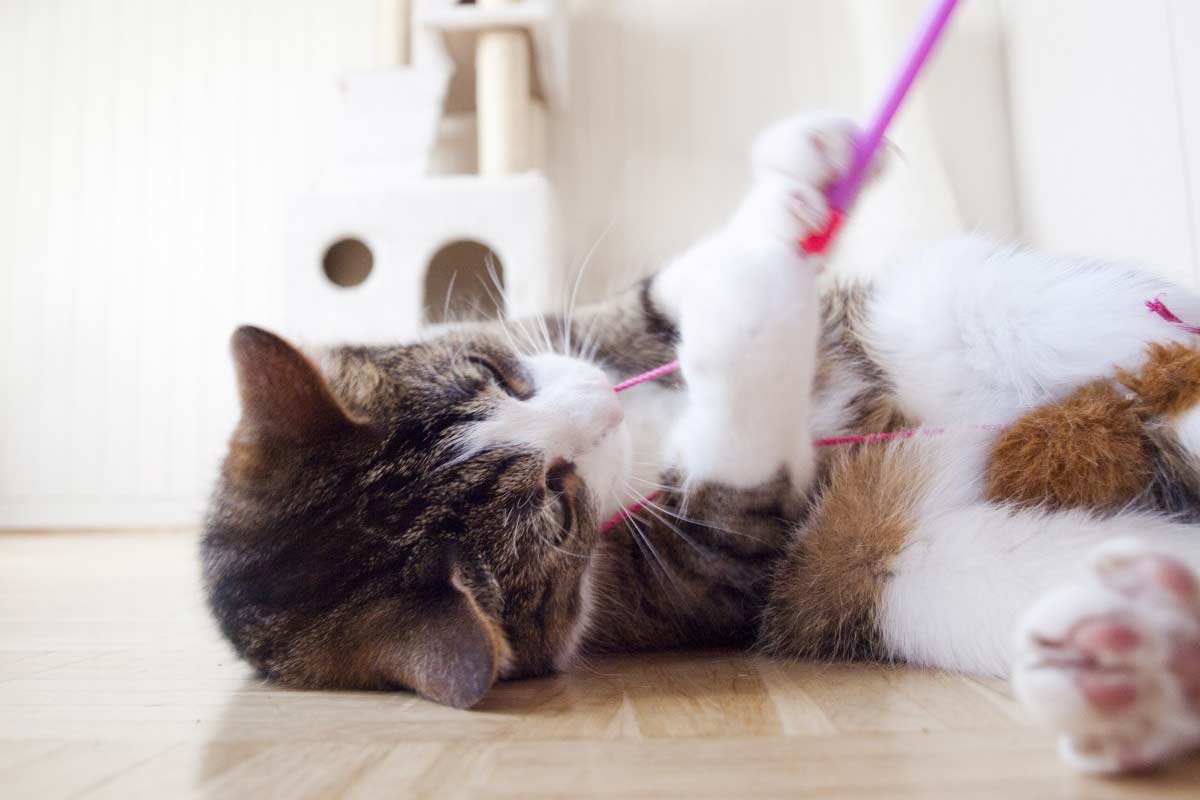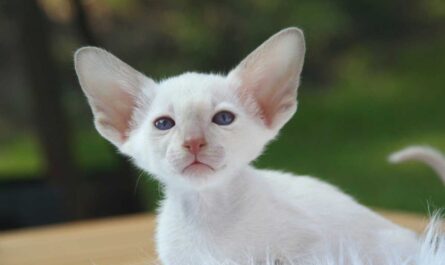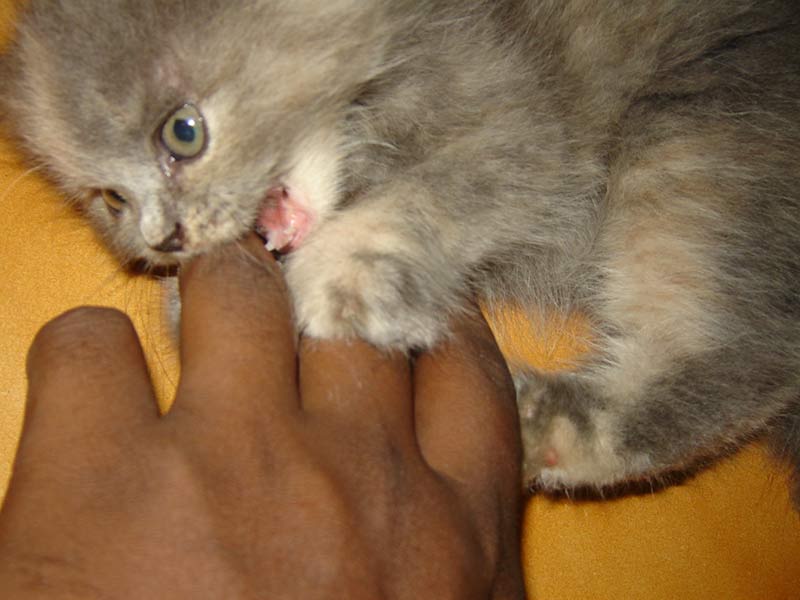How to correct kitten behavior and play with proper training? Kittens are renowned for their playful nature. But why is play so crucial for them? Well, play serves as a vital part of the feline world, where kittens not only have fun but also acquire essential adult skills necessary for communication and hunting.
Right from their early days, they engage in play with their littermates and explore their surroundings through playful activities. This playtime allows kittens to investigate the world around them. In their youth, kittens exhibit behaviors like chasing and pouncing, which can be traced back to their predatory instincts.
Predatory play is a fundamental aspect of feline behavior and early learning. It might sometimes seem intense and aggressive, but it’s an essential developmental phase. As kittens grow, they engage in three distinct forms of play. Up until weaning, most of their playful interactions revolve around their mother and littermates, which is termed social play.
Upon weaning, kittens begin to show more interest in objects in their environment. They start exhibiting behaviors associated with hunting, like chasing, stalking, batting, and swiping at moving objects. This phase is known as object play and plays a significant role in developing their eye-paw coordination and hunting skills.
Having an experienced hunting mother around helps kittens observe the right behaviors and hone their hunting abilities. Locomotory play becomes fully developed when kittens reach 10 to 12 weeks of age, contributing to their balance and agility. Given the importance of play in a kitten’s development, it’s crucial to encourage proper play and exercise.
Feline Behavior Problems: Destructive Behavior
Many cat owners face the frustration of seeing their beloved feline friends scratch furniture, chew fabric, or nibble on houseplants. These seemingly destructive behaviors not only harm your cherished possessions but can also pose health risks to your cat. A common myth is that cats engage in these activities out of vengeance, but in most cases, they are simply satisfying their natural instincts to explore and play. The good news is that with the right approach and patience, these behaviors can be redirected and managed effectively.
- Cat Health Supplies on Amazon
- Cat Food Supplies on Amazon
- Cat Scratching Posts for Indoor Cats
- Cat Water Fountain on Amazon
- Cat Carrier on Amazon
- Cat Automatic Feeders on Amazon
- Cat Guide Book on Amazon
Scratching: More Than Meets the Eye
When your cat scratches your prized sofa or costly curtains, they aren’t on a mission to obliterate your home. Instead, they’re driven by certain needs and instincts. Scratching is, in large part, a marking behavior. Cats have special scent glands on their paws, and scratching deposits their scent into their territory. It also helps remove the translucent claw sheath, which can be seen as a display of confidence.
Given that scratching is an innate behavior, akin to grooming or burying waste, it can be challenging to curb. However, cats can be taught to scratch more appropriate objects, such as scratching posts. Here are three strategies to help redirect your cat’s scratching tendencies:
- Identify Scratching Preferences: Start by observing your cat closely. What types of surfaces does she prefer to scratch? Carpets, drapes, wood, or something else? Does she scratch vertically or horizontally? Once you understand her preferences, you can choose a scratching post that matches her needs.
- Provide Suitable Options: Pet stores offer scratching posts in various shapes, sizes, and textures. For instance, if your cat likes scratching carpets, opt for a carpet-covered post. If she prefers nubby surfaces like couches, select a post with sisal or rope-like material. The post should also align with her scratching orientation. A cat that climbs and scratches drapes may prefer a tall, wall-mounted post, while one that enjoys horizontal motion might favor a flattened cardboard box or a log on its side.
- Make Unacceptable Targets Unattractive: If restricting access to undesirable areas or objects isn’t feasible, you can set up deterrents. Create a tower of plastic cups that tumbles when touched, startling your cat when she begins to scratch. Covering items with blankets, plastic sheets, or double-sided tape can also discourage scratching. Another option is an indoor fence that delivers a harmless shock when your cat crosses a boundary.
Because scratching involves scent marking, cats are likely to re-scratch areas they’ve already marked. To break this cycle, consider using an odor neutralizer to remove their scent.
You can further minimize scratching damage by regularly trimming your cat’s nails or applying plastic nail caps. These caps, which are glued over the claws, can help prevent damage while allowing your cat to perform the scratching motion. Replace the caps every six to twelve weeks.
Understanding Your Kitten’s Mischief
Another crucial aspect of a kitten’s development is its need to explore and investigate new objects and environments. While this curiosity is natural and healthy, it can sometimes lead to interior damage or harm to the kitten. The solution lies in recognizing your cat’s need to play and explore. When you’re not available to supervise, provide your cat with a variety of toys designed for batting, chasing, and pouncing.
- Buy Cat Accessories on Amazon
- The Complete Guide to Adopting a Cat: Preparing for, Selecting, Raising, Training, and Loving Your New Adopted Cat or Kitten
- Amazon Best Sellers: Best Cat Training
- Amazon Best Sellers: Best Pet Cats
- Amazon Best Sellers: Best Cat Care
- Amazon Best Sellers: Best Cat Care & Health
- Amazon Best Sellers: Best Cat Breeds
Options include toys stuffed with catnip, ones that dispense food when manipulated, battery-operated or mechanical toys that invite pawing or chasing, and toys that can be dangled from doors or play centers. Additionally, ensure your cat has suitable opportunities for scratching, climbing, perching, and relaxation. These might include scratching posts and toys, shelves, counters, windowsills, play centers for perching, and paper bags or cardboard boxes for exploration.
How to correct kitten behavior and play with proper training?
When circumstances keep you from supervising your feline friend, there are ways to safeguard your home and your cat’s well-being. Create a cat-proof area with comfortable bedding and a litter box for your cat to enjoy when you can’t be present. However, before confinement, make sure your kitten has had sufficient play and attention to keep them content. While a large dog kennel or cat crate can work for short periods, most cats can be comfortably confined to a few well-prepared rooms.
This grants them some freedom while curbing any potential damage or accidents. Employ child locks and secure containers to keep your cat away from cupboards and garbage cans. Items that might become scratching posts, prey to be pounced on, objects to be explored, or items to be knocked around should either be kept out of reach or rendered uninteresting. Remember, with their adept jumping and climbing skills, damage prevention might need to extend beyond ground level.

To discourage your cat from specific areas, you can make those spots unpleasant. Before doing this, ensure the confined space offers enough room to meet your cat’s innate needs. Provide a scratching post, shelves for climbing and perching, and a variety of play toys like those that can be swatted, batted, or chased. Toys on springs, items hung from doors or play centers, ping-pong balls, whole walnuts, or catnip mice often provide hours of amusement.
Cat play centers, whether bought or constructed, offer spaces for perching and scratching in a compact area. Some cats enjoy exploring new objects, so a few empty boxes or paper bags (never plastic) can keep them entertained. In some cases, the ideal solution might be adding a second cat for companionship and play. Ensure the second cat is young, sociable, and playful.
- Cat Products for Indoor Cats
- Cat Toys for Indoor Cats Best Sellers
- Surprise Subscription Boxes for Cool Cat On Amazon
- Build Your Cat Box. 1 Box Every 3 Months
- Litter Boxes for Your Lovely Kitten On Amazon
- Toilet Training Kit for Your Cute Cat On Amazon
Cats have a unique way of expressing themselves, and sometimes, it can involve behaviors that seem problematic to us humans. In this guide, we’ll explore some common feline behaviors and how to manage them effectively.
1. Scratching Woes: A Natural Instinct
Cats scratch for various reasons, but it’s essential to understand that they’re not out to get you or your furniture. Scratching is a natural behavior that helps them mark their territory and shed the outer sheath of their claws. Punishing your cat for scratching is ineffective and can lead to fear and aggression.
Redirecting Scratching: A More Effective Approach
To steer your cat away from your favorite sofa, observe their scratching preferences. Do they favor vertical or horizontal surfaces? Once you know their inclination, invest in a suitable scratching post. These come in different textures and shapes to cater to your cat’s specific needs. Gradually move the post to your preferred location and reward your cat when they use it. Avoid discarding worn posts; they’re fulfilling their purpose.
2. The Debate on Declawing: A Controversial Procedure
Declawing, despite its name, is not a simple nail removal but a surgical amputation of the bone tips in a cat’s paws. It’s a contentious procedure with risks such as anesthetic complications and infection. While it prevents damage from scratching, it doesn’t curb the behavior. Declawed cats should remain indoors as they lose their ability to climb or defend themselves. Consult your vet only when all alternatives fail and scratching jeopardizes your cat’s place in your home.
3. Fabric Chewing and Sucking: A Less Common Behavior
Some cats develop a habit of chewing fabric, which can be a comfort-seeking or exploratory behavior. Kittens may do it while exploring, and while most outgrow it, certain breeds, like Burmese and Siamese, may continue this behavior throughout life.
- Cat Breed Book on Amazon
- Cat Behavior Book on Amazon
- Cat Training Book on Amazon
- Cat behavior Products on Amazon
- Cat Breed Test
- GPS cat, dog, and Pet trackers
- Cat leash and harness set
Prevention and Alternatives: Keeping Your Cat Safe
Hide valuable and dangerous objects from your cat’s reach. Offer non-valuable fabrics for chewing and provide cat-safe rubber toys or dry cat food. Ensure the food given doesn’t lead to overfeeding. Keep your cat engaged with a kitty condo or interactive play. Playtime with ribbons or toys like walnuts can be beneficial. To meet their foraging needs, use toys that dispense treats.
4. Houseplant Chewing: A Vegetarian Craving
Indoor cats may chew on houseplants due to their limited access to greens. While most plants are harmless, some can be toxic. It’s crucial to ensure both your plants and your cat’s safety.
Preventing and Deterring Houseplant Chewing
Block access to houseplants to guarantee safety. Provide alternatives like oat grass, catnip, or catmint. You can add lettuce or parsley to their food or opt for high-fiber cat food. To make plants less appealing, try pet repellents or cayenne pepper on leaves, mothballs in the soil, or use the “tower of cups” booby trap.
While some might view confinement, cat-proofing, and making areas unpleasant as unnecessary or cruel, they’re actually preventive measures to keep your cat safe and your home damage-free when you can’t supervise. These measures help prevent common owner complaints, such as plant-chewing, inappropriate scratching, climbing or playing in unwanted spots, or litter box issues. When a family member is home and available to supervise, your cat can explore and become accustomed to areas that might otherwise cause problems.
5. Choosing the Right Toys for Your Kitten
Kittens consider various objects as prey during play, involving activities such as stalking, pouncing, jumping, biting, and clawing. They often prefer smaller objects that can be easily manipulated with their paws or held in their mouths. However, it’s vital to avoid objects that are so tiny they might be ingested, potentially causing intestinal blockages. Some kittens enjoy playing with items like string or yarn, but these can be hazardous if swallowed accidentally, so they should only be used under supervision.
Using your hands as play objects is not advisable, as it can lead to human injury. A moving hand may seem like an appealing play target for a kitten. While a young kitten may not cause harm, as it grows and continues using your body for play, it can result in injuries.
- Buy Bird Accessories on Amazon
- Buy Cat Accessories on Amazon
- Buy Dog Accessories on Amazon
- Buy Fish Accessories on Amazon
- Buy Pet Accessories on Amazon
Cats are stimulated by moving prey, so toys like wands or items that can be dangled in front of them are particularly enticing. Fishing rod-type toys and long wands with prey-like attachments such as feather toys or catnip mice can engage your kitten in play without involving your body. Young kittens may even enjoy fetching small fleece toys or batting them around.
Addressing Play-Related Problems
Overexuberant and inappropriate play can lead to behavior problems in cats. Examples include cats that wildly dash around the house, those that swat or pounce on their owners (sometimes leading to bites and injuries), and those that nip, bite, or swat at their owners during the night.
Preventing Overexuberant Play and Play Attacks
To prevent overexuberant play and play attacks on people, start by providing ample opportunities for play and outlets for your cat’s energy. Choose play toys and activities that appeal to your individual cat. Since play initiated by the cat might escalate into overly aggressive behavior, it’s wise for you to select play toys and initiate play sessions. Sessions initiated by the cat should be ignored or interrupted using a distraction device.
In Conclusion: Balancing Needs and Behavior
Cat behaviors, though sometimes destructive indoors, are usually innate and natural. Finding a balance between protecting your possessions and your cat’s well-being is essential. In challenging cases, consult a veterinarian or veterinary behaviorist for expert guidance and strategies to ensure both you and your cat live in harmony and good health.
More Interesting Articles
- 23 Essential Health and Care Tips for New Cat Owners
- 14 Tips How To Introduce & Habituate a Kitten to a Cat
- 15 Top Reasons to Adopt an Older Cat Is a Good Option
- Should I Get A Cat or a Kitten? 15 Tips to Take Decision
- 19 Ways Cats Show Their Love & Affection to You
- How to Bathe Your Cat: With or Without Water, Not Do-Do
- Reasons Why Does My Cat Poop on My Bed? 16 Solutions
- Why is My Cat Pooping Outside the Litter Box: 12 Reasons
- 14 Cat or Kitten Behavior: How to Understand & Handle
- 8 Reasons to Decide Which is Better for You: Cats or Dogs?
- 34 Interesting Facts People Love to Learn about A Cat
- How to Get My Cat to Successfully Use the Litter Box
- A Complete Guide: How to Find the Perfect Cat for You
- How to Cut, Clip, or Trim Cat Nails: A Beginner’s Guide
- 30 Tips to Find the Best Way to Raise A Kitten Smoothly
- Egyptian Mau Cat Breed Profile, Care, Description, Behavior
- 10 Best Food for Older Cats with Sensitive Stomachs
- 10 Best Litter Boxes for Cats That Pees Over the Side
- 5 Best Cat Food Items for Sensitive Stomach Vomiting
- Best 5 Cat Food For Sensitive Stomach and Urinary Health



